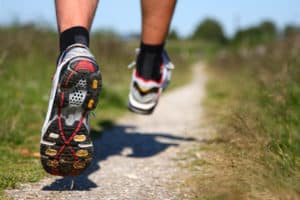Shin splints are another pesky problem that develop this time of year, but Laurel physical therapy and some rest will help to address it

April 28, 2017
In our last blog, we explained how plantar fasciitis is a fairly common injury that we see this time of year because so many people are getting back into their outdoor exercise routine, especially runners. Another injury that pops up pretty regularly with warmer weather is shin splints, which can prove to be a real nuisance. Fortunately, a course of Laurel physical therapy, along with some rest, will usually address your pain and get you back out there exercising in no time.
Shin splints typically arise after any sudden changes in physical activity, such as altering the duration, frequency or intensity of your workout. Runners are at the highest risk of developing shin splints, but they can occur in athletes of any sport that requires lots of running. People with flat feet or high arches are also at an elevated risk for shin splints.
What happens in these situations is the muscles, tendons and bone tissue surrounding the tibia (shinbone) become overworked and inflamed by this repeated activity. This inflammation manifests as pain along the border of the tibia that can be sharp or dull, and it may come about either during or after any type of physical activity.
If you’re a runner and you plan on significantly increasing your weekly mileage or if you’ve recently started a new outdoor physical activity that involves lots of running, you may be familiar with the bruise-like pain of shin splints. Pushing through the pain will only make matters worse, but there are some measures you can take to prevent shin splints from occurring in the first place or treat them if they do wind up developing:
Prevention
- Always wear properly-fitting shoes, especially while running or working out; go to a physical therapist or a specialty shoe store to have your gait analyzed, which will help you determine which shoes are best
- Slowly and gradually build your fitness level and be careful not to overdo it
- For the avid runners, try integrating some cross-training into your exercise routine like swimming or biking to reduce pressure on your legs
- Barefoot running may also help, but be sure to follow a transitional program before starting up
Treatment
- RICE: Rest for several weeks from the activity that caused shin splints; Ice the area for 10 minutes at a time, several times a day; use an elastic Compression bandage; Elevate the leg above the heart regularly
- Physical therapy treatment typically includes the following:
- Strengthening and stretching exercises: for the entire lower body with specific exercises for the shin to re-strengthen damaged muscles
- Ultrasound and electric stimulation: to reduce overall pain
- Massage: gentle massage that may progress to deep-tissue massage
- Correction of imbalances and biomechanical faults
- Before returning to activities, you should be pain-free for at least two weeks and should return at a gradual pace and warm-up/stretch regularly
If you’ve recently noticed any of the symptoms of shin splints or are concerned with your risk, Laurel physical therapist Pamela Rhone and our other therapists at CAM Physical Therapy and Wellness Services can help by providing you with targeted treatment and other tips to prevent future injury. Contact us at 301-776-9443 to schedule an appointment at any of our three clinics in Laurel, Hyattsville, or Glenn Dale/Bowie, MD today, or click here for more information on shin splints.